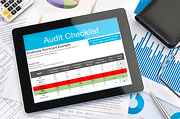
In my last blog Revenue Cycle Management, Way Downstream I said employee scorecards are a great tool to use within a revenue cycle management strategy. I wrote this blog to pass along tips and techniques for setting up and administering employee scorecards. Click here to download a sample Employee Scrorecard template.
Why Employee Scorecards?
- The best peer’s performance within a team can be used to establish true performance benchmarks and real performance targets (other peers strive to meet and beat the best). Note: different people have different strengths so “best” benchmarks for different categories will come from different team members.
- Set up the right way, employee scorecards can give managers a very objective tool for:
- Measuring and evaluating the strengths and weaknesses of team members (overall strengths/weaknesses and line item strengths/weaknesses).
- Determining where to devote time and energy (get out of the way of the best, close gaps on weak links, and work to bring up the rear).
- Performance planning, performance evaluations, and differentiation(compensation, rewards, and eligibility for promotions).
- Set up the right way, employee scorecards should map core activities within a job to the overall completion and success of that job.
- Administered the right way, employee scorecards motivate employees on three fronts: 1) report outs give employees individualized development plans (elements of a job that can be improved upon) 2) by watching changes in reports, employees can monitor their individual progress and 3) published reports give employees an opportunity to show others the great work they do every day.
How to Establish and Administer Employee Scorecards
- Job # 1 is to break jobs down into logical and quantifiable parts (download the sample employee scorecard for an example). Like I said in a previous point, the sum of the parts should map to the overall success of that job.
- Employees (the people that do the jobs) and managers should have lots of input into the development of employee scorecards (you’ll do a better job of getting the parts right and you’ll get buy-in from the employees who’ll be on the hook for results).
- Job # 2 is to develop methodologies for capturing and calculating results
- The source of the data has to have integrity
- The methodologies for calculating results need to be consistent and understood
- Weight elements according to what matters most (download my sample employee sorecard to see an example of weighting)
- Publish reports to a regular distribution with a regular frequency
- The idea of publishing scorecards with names scares a lot of people – especially if the scorecards are shared outside an immediate workgroup. Publishing scorecards is the right thing to do. Here’s why:
- Knowing others are effectively watching should give employees additional motivation to excel
- Scorecards give others outside the team (like senior managers) a tool to recognize top performers
- Again, published scorecards give great employees an opportunity to show others the great work they do everyday
- The idea of publishing scorecards with names scares a lot of people – especially if the scorecards are shared outside an immediate workgroup. Publishing scorecards is the right thing to do. Here’s why:
Pitfalls to Avoid
- When used the right way, employee scorecards can be an awesome tool to develop, motivate, and reward employees. Employee scorecards can also be a terrific tool for identifying employees that are not a right fit for a job. Both outcomes are great professional outcomes that work to continuously better teams. Unfortunately, amateur managers and/or mean bosses might use employee scorecards for negative reasons (berating employees, publicly calling people out for lagging results, focusing only on negative results). When used the wrong way, employee scorecards become counterproductive and demoralizing.
- Sometimes defining a peer group isn’t an exact science (day shift/night shift, new hire/tenured employee, east coast/west coast). When setting up employee scorecards, it’s important to logically define and account for differences that’ll affect results.
- Like any good reporting consistency is key. Employee scorecards should be produced on a regular frequency to a regular distribution. Irregular production and distribution leads to a lack of interest.
I’ve had a great deal of success using scorecards to manage vendors and employees – they work.
As always, I’m interested in questions, comments, and feedback. Please feel free to contact me anytime.
Phone: 484-459-8723, e-mail: rstein@varohealthcare.com





